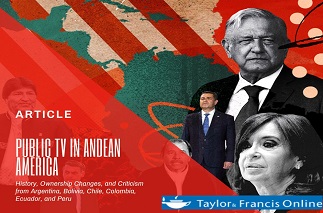Posts

Apomediation and Disintermediation: YouTube Prescribers on Fad Diets
As a result of the confinements of the COVID-19 pandemic and the sedentary lifestyle due to teleworking, there is an increase in weight gain and dietary carelessness in the population, which leads to an increase in offers of fad diets based on recommendations made by digital influencers. The aim of the study was to examine the characteristics of dietary recommendation videos made by non-health professional prescribers in Spanish and English to understand what patterns are followed by the productions of this type of content and what effects they have on the interaction they receive. An exploratory walkthrough method analysis was applied to define the variables of a codebook, followed by a content analysis of a sample of 50 videos published between January 2020 and July 2021. Most of the videos are published in the first months of the year, probably aimed at users seeking to reduce the weight gained during Christmas. The productions were characterized by having a very personal tone, informative and with relatively plural information, sometimes addressing the risks of diets or slimming products, and, although recommendations abound, the voices of experts are not frequent. The products and diets addressed in the videos often have a high health risk and do not involve practices recommended by experts, so although sometimes their contraindications or associated risks are pointed out, the promotional component and the search for traffic to the channel seem to be more relevant factors than public health in these videos.

‘Millennials and centennials’ perspective on Streaming narratives in Spain and Mexico: Spiral of silence, bandwagon effect, and third person effect
Viewers are increasingly used to the link between entertainment and technology in the current media ecosystem. The success of consuming streaming platforms when watching movies and series shows how the audience is more involved in new forms of viewing, at any time, at any moment, and with any content. This research aimed to examine the perception of millennial and centennial audiences in Spain and Mexico, the two Spanish-speaking countries with the highest streaming consumption, about audiovisual content producers for entertainment. Three theories on public perception (spiral of silence, bandwagon effect, and third-person effect) were used as the basis of the research questions to unravel the extent to which younger audiences in these countries consider that production companies are, or are not, ethical in the representation of what may be labeled as "sensitive topics". The results show that centennials are more confident in their critical perceptions of controversial issues in movies and series, while, on the other hand, millennials approach their perceptions with more cautiousness and confusion.

The Process of The Transfer of Hate Speech to Demonization and Social Polarization
We are living through a time of major political changes due to the rise of populist leaders and the resurgence of extreme ideological movements. The emergence of this phenomenon is due, to a large extent, to the ease with which these political actors can disseminate and spread their messages without any limits through social networks, leaving aside the former “fourth power” of the media as filterers and reinterpreters of information. Generally, the formula used by these leaders and movements is usually based on symbolic social division and polarization through hate speeches that allow demonizing their adversaries while antagonizing the issuers: a discursive “us” against “them” based on verbal violence to dehumanize an “exogroup.” We want to discuss the importance of understanding the process of communicational transfer—which begins with hate speech and evolves into demonization and social polarization—as a strategic basis for creating an ideal scenario for the growth and strengthening of populist discourse, which is reductionist and simplifying in nature.

Integrated research model for web interfaces: toward a taxonomy of quantitative and qualitative analysis for digital native media
In a context marked by the emergence of new platforms and interfaces, digital native media face the challenge of organizing and presenting their content in an effective and eloquent way. This milestone requires ongoing work toward the identification and conceptualization of the dimensions that map the structural and formal requirements necessary for fluid communication with audiences and adequate visibility in the digital ecosystem. This study, which adopts a quantitative–qualitative methodological design, proposes, describes, and applies a taxonomy for the analysis of digital media web interfaces. Based on a review of the literature, two rounds of expert judgment, and a pilot test, the research identifies 14 thematic dimensions, 36 indicators, and 69 variables. The study focuses on the importance of renewing research about taxonomy related to structural dimensions that address narrative, quality, usability, information search, and content redissemination and socialization, among other aspects. The study of web interfaces applied to journalism demands long-term research work with a holistic approach that, at a conceptual and practical level, can offer proposals for analysis and diagnosis on the basis of an integrated method.

OK, Boomer: New Users, Different Platforms, New Challenges
The popularization of new interaction spaces brings new narratives and social phenomena that merit attention from the scientific community. Based on the existing literature on the new challenges facing the communication discipline with these emerging narratives, this editorial summarizes the empirical and theoretical contributions of the thematic issue entitled “New Narratives for New Consumers: Influencers and the Millennial and Centennial Generations.” The authors emphasize that the studies selected for this thematic issue explore the innovative features and opportunities of the emerging scenarios and offer a cautionary account of their structural problems and the urgency of a new media literacy.

Populist attitudes and perceptions of public opinion and the media: A comparative correlational study between Spain and Colombia
Populism has experienced a worrying growth in the last decade in different locations around the world. This globalizing process has been enhanced by the immediacy, interaction, and participation of social networks, cyber media, and other digital platforms. In this context, the perception that young people give to this type of phenomena constitutes a field of study of great interest for the Social Sciences. This research examines the correlations between populist attitudes, perception of public opinion, and opinions about the media in students of Communication Sciences in Colombia and Spain. Methods: Based on an exploratory-correlational approach and a quantitative design, this research has analyzed the reflections and priorities of a group of n=499 undergraduate and graduate students related to Communication Sciences in Colombia and Spain. Results: The study has confirmed the leading role played by social networks in the formation of radical opinions while detecting a decline in the influence of television among young audiences. In addition, the study establishes that the index of public opinion perception is higher in Spain, while the index of media perception or anti-elitist attitudes is higher in Colombia, and there is no clear link between populist attitudes and a political ideology of extremes. Conclusions: The correlations examined note a tendency towards disaffection and discredit towards politics in general, especially by the young population, which affects actors and institutions. It alludes to the preference of this population group for interacting and informing themselves on digital platforms and presents populist attitudes, without clear ideological identification, but with a clear tendency towards simplification of messages, thus emphasizing the need to educate the critical view of citizens and to work on media literacy as a crucial strategy against the growth and expansion of populism.

Symbolic-discursive violence and new media: An epistemological perspective
The following research studies, from a theoretical perspective, the different forms of symbolic and discursive violence and the transmission of hate speech through new media. The main objective is to understand the consequences of symbolic violence through language and how this affects freedom of expression. Reflective and critical argumentation is highlighted through an exploratory analysis carried out by a literature review, where it is determined that the confrontational narrative used by the media contributes to the dehumanization, demonization and polarization of specific collectives.

The «ventriloquist effect» of the international news agencies. Theoretical review and incidence on new forms of misinformation
This research reflects, from a theoretical perspective, how most of the international events that reach the rest of the media are disseminated through news agencies, causing the well-known «ventriloquist effect»: multiple media, a single voice; and explores how online platforms have fostered this phenomenon, causing a structural increase in misinformation. In this sense, the research aims to understand the development of the «ventriloquist effect» with the progress of «new media» and, as a consequence, the increase of disinformation. For this grounded theory documentary analysis, the methodological procedure was based on the bibliographic review of the literature in the international reference databases (WoS and Scopus), carrying out an analysis of primary studies to synthesize the information. The results indicate, among other issues, that social networks foster spaces of structural misinformation in the current ecosystem. In conclusion, the relationship between the "ventriloquist effect" and misinformation, which arises from reticularly and information-digital decentralization, is determined.

How to Botox’ on YouTube: Influence and Beauty Procedures in the Era of User-Generated Content
The current media environment is complex and has important effects on all aspects of life, including beauty and health. In this sense, YouTube has become one of the main contexts for the dissemination of tutorials and content related to medical procedures such as the application of Botox. Thus, the present study constitutes the first exploratory analysis of YouTube videos in Spanish related to this procedure. A preliminary analysis of 221 YouTube videos yielded a final sample of the 50 most viewed videos within this genre. The analysis was carried out through a quantitative content analysis assessing the popularity of the videos, contact and emotive strategies by the creator, the credibility conveyed, and the characteristics of information about the procedure itself. Results suggest that these influencers align with mainstream Internet celebrity culture in practices that aim at increasing their following and views, as well as calls for subscriptions and visits to other platforms and profiles. Moreover, they include different strategies to establish their credibility but emphasize personal experience. The positive portrayal of the procedure, including positive emotions and content that highlights the benefits, is interesting and supports the commercial nature of much of the content.

Public Television In Andean America: History, Ownership Changes, and Criticism From Argentina, Bolivia, Chile, Colombia, Ecuador, and Peru
This paper analyzes and describes public television in Andean America through the historical, hermeneutic, and non-participating observation method, carrying out a critical review of the literature, legal provisions, and official websites. The research reveals the appearance and precariousness of Andean-American public television, its financing, and particular administration forms. Twenty-four stations were identified as having evidence of public ownership, of which only eight are close to the principle of public service TV. There is little evidence of the existence of public service television because of the political-ideological control of the public media by the various governments, especially by populist regimes. Also, public television in the Andean region suffers from the cultural contamination of banal commercial content and infotainment.
